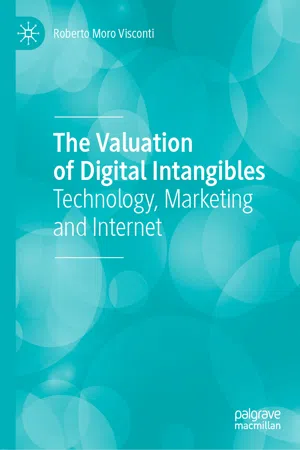An intangible is a non-monetary asset that manifests itself by its economic properties. It does not have physical substance but grants rights and economic benefits to its owner.
Intangibles are the core component of modern competitive advantage that expresses the leverage of a business over its competitors. According to Michael Porter, firms can achieve a competitive edge with cost or differentiation advantage. Intangibles play a crucial role in both strategies, bringing to cost savings (with know-how, patents, etc.) or differentiation (using brands, etc.), and fostering a structural shift in business models.
This traditional value driver has been amplified by a new generation of Internet-related
intangibles, driven by the growth of the service economy and the
digital explosion. The digital revolution reshapes traditional intangibles and creates new ones:
Digital brands are indissolubly linked to their web domains;
Know-how and patents follow product and process innovation fueled by artificial intelligence and blockchains;
Networks become social through their digital platforms, using M-apps to access the web;
Technological startups ignite the creation and marketing of innovation and frontier applications, fully reengineering old-fashioned business models;
The information has become a worthy asset, nurtured by big data and Internet of Things sensors;
Interoperable databases share and recombine information in real time, adding up value;
Digital applications are to this century what oil represented for the past one: a driver of growth, wealth, and change.
The digital economy shows unprecedented opportunities but also unconventional threats, represented by cyber-crimes, monopolistic rents of tech-giants, and disruption of many “analogic” jobs. Even the expression “digital” may have different meanings, since it may refer either to an IT world or—in Botanics—to digitalis purpurea (commonly called foxgloves), an attractive but poisonous plant.
Digital intangibles are typically embedded in catching-up traditional firms or innovative startups. The valuation framework may so conveniently start from the standard valuation approaches of the firm and then incorporate intangibles in a more comprehensive appraisal.
In general terms, the accounting treatment of the intangibles remains controversial, and their capitalization is typically prohibited for reasons of prudence. This may bring to an underestimation of the book value of intangible-intensive firms.
Intangibles are more specific than other assets and incorporate higher
information asymmetries, linked to higher risk profiles and lower
collateral value.
Intangible assets are usually hard to evaluate, and according to the International Valuation Standard 210, they can be appraised using:
- (a)
An income approach (present value of income, cash flows, or cost savings attributable to the intangible asset over its economic life);
- (b)
A market approach, concerning market activity (e.g., transactions involving identical or similar assets);
- (c)
A cost approach (replacement cost of a similar asset or an asset providing comparable service potential or utility).
This book innovatively combines classic aspects of traditional intangibles (like patents or trademarks) with trendy immaterial assets and processes (like big data, IoT, artificial intelligence, blockchains, social networks, etc.). Hard-to-value intangibles are those that have the potential to create cash flows in the future but do not right now and may concern undeveloped patents or real options (to expand, abandon, suspend a business) or product and process innovation (like the impact of blockchains on digital supply chains).
Eighteen chapters describe these complementary topics. They start from some general issues that concern the primary valuation approaches (Chapter 2), then considering the value drivers embedded in digital scalability and intangible-driven growth options (Chapter 3).
The taxonomy recalled in the title—technology, marketing, and the Internet—broadly recalls the classification of the main intangibles, although they often overlap, even due to their immaterial nature.
The value drivers incorporated in the intangibles are the result of their characteristics, as scalability (the ability to grow exponentially and fast) or non-rivalry (intangibles may be simultaneously used by an unlimited number of customers, with no marginal extra-costs).
Technological intangibles are mainly represented by know-how (to do it), a broad concept examined in Chapter 4 that embraces industrial secrets that in most cases intentionally remain unpatented. Unlike patents, the know-how is not independently negotiable and is more difficult to enforce against third parties. At the same time, it retains some characteristics of confidentiality that with the patenting in part must be disclosed.
Patents (analyzed in Chapter 5) are the result of risky and costly R&D, and the developer will try to recover its costs (and earn a return) through the sale of products covered by the patent. Patents are typically valued for litigation or licensing purposes.
Innovative startups (investigated in Chapter 6) are newly formed companies with high growth potential, which usually absorb a lot of liquidity in the early years of life, to finance development, against minimal collateralizable assets. This is unattractive for traditional banking intermediaries, usually replaced by other specialized intermediaries such as venture capital or private equity funds. The technological footprint implies evaluation analogies with patents, know-how, and intangibles linked to specific sectors (biomedical, Internet, etc.).
A versatile intangible that has technological and web-based features is represented by software (examined in Chapter 7), generally understood as a sequence of computer instructions for performing functions on devices such as hardware.
Software and its sequential algorithms are the engines behind artificial intelligence (AI). AI (analyzed in Chapter 8) allows us to think and act humanely and rationally through hardware systems and software programs capable of providing performances that, to an ordinary ...
